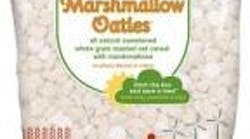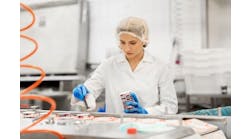Using less packaging can be good for the environment, but it can also deliver business benefits by reducing packaging costs. No processor understands these dual advantages better than family-owned MOM Brands, Minneapolis.
MOM Brands, formerly Malt-O-Meal Co., has long focused on keeping packaging and other operating costs down to ensure competitive pricing for its products. A key tactic is to use bags instead of bag-in-box packaging for its ready-to-eat cereals.
Currently about 90 percent of MOM Brands' cereals are packaged in resealable bags. These products include Honey Nut Scooters, Crispy Rice, Golden Puffs and Frosted Mini Spooners. Three Sisters- and Bear River Valley-branded cereals also are packed in bags. The company only uses paperboard cartons if retailers won't accept cereal in bags, or if consumers are so biased against bags that they'd snub the product if it were sold without a box.
"We started packaging our cereals in bags when we started producing ready-to-eat cereal back in the mid-1960s," says Linda Fisher, director of marketing communications for MOM Brands. "We did it primarily because it was a cost-saving packaging solution. We don't need a paperboard box covering the bag. And over time we have maintained that."
The cost component is essential, as MOM Brands' business strategy combines "high-quality cereal, bag packaging and affordable pricing," Fisher explains. A product like MOM Brands' Coco Roos, for example, provides a lower-cost alternative to General Mills Cocoa Puffs.
Is it time to bag the box?
With consumers' interest in ecological issues growing in the past several years, MOM Brands recognized that its bag packaging could be a strong selling point—if consumers fully understood the bags' green benefits.
[pullquote]
To get the word out, the company launched its Bag the Box campaign in 2010. Bag the Box works with traditional media and social media such as Facebook and Twitter to educate consumers about the environmental virtues of bags versus boxes.
Although MOM Brands' bags are not recyclable, they provide noteworthy waste reduction benefits, versus bag-in-box cereal, by eliminating a layer of packaging. According to the company, its packaging system creates 75 percent less consumer packaging waste.
Also, according to the Bag the Box website, more than 2.3 billion cereal boxes are produced in the U.S. annually. Manufacturing them requires 345 million pounds of paperboard and, to power the box plants, 2.4 trillion BTUs of energy. With regard to shipping, the site explains, "If the boxes travel 100 miles to get to the cereal plant (conservative guess), this consumes 1,400 tons or the equivalent of 46 tanker trucks full of fuel."
To save money, MOM Brands doesn't advertise on television. But its cost-effective Bag the Box campaign, which has generated plenty of buzz, shows that TV ads aren't necessary to engage consumers. Fisher says the campaign generated 55 million media impressions and 4.2 million video views in its first 18 months.
Upcycling into the future
TerraCycle accepts bags from Malt-O-Meal, Three Sisters, Bear River Valley, Isabel's Way and Sally's cereals. The Cereal Bag Brigade collects about 25,000 bags per month.
MOM Brands also ships to TerraCycle all film that it cannot use for packaging, such as ends of film rolls and waste generated when changing over equipment. The company's bag material is made from a food-grade, polyethylene-based film; details of the multilayer film's structure are proprietary.
TerraCycle currently is conducting a pilot program that lets individual households pack up mixtures of used packaging and ship them to TerraCycle for upcycling. MOM Brands is one of the brand owners participating in the pilot.
"This would give every consumer who buys a package of our cereal the ability to send it someplace where it would be repurposed and made into something else," Fisher says. "That's a great end-of-life solution."
Beyond the package
MOM Brands' environmental and financial sustainability efforts extend well beyond packaging, shaping its plant operations and shipping practices. The company buys renewable (wind) energy credits to offset all the electricity used to make its broad assortment of natural cereals. These products are sold under the Mom's Best Naturals, Isabel's Way, Bear River Valley, Three Sisters and Sally's brand names.
In addition, the company has created strict waste-reduction goals for its plants. "The goal is to recycle 95 percent of our waste, and we have hit that in our largest plant [Northfield, Minn.] year after year," Fisher says, noting that even food waste is recycled — by pig farmers. The plants also make it a priority to reduce energy and water use.
To improve shipping efficiency, the company participates in the U.S. EPA's SmartWay Transport Partnership. The SmartWay program helps companies improve their carbon footprint by reducing greenhouse gas emissions related to shipping freight.
MOM Brands is active in the Carbon Disclosure Project (CDP), as well. CDP is an international not-for-profit organization that collects and reports data on companies' greenhouse gas emissions, climate change strategies and water use.
Bottom line
The success of MOM Brands' strategies vis-à-vis packaging and operations is evident in its financials. According to Fisher, sales figures show that "our ready-to-eat cereal business is up 7.1 percent, in dollars for 2012 year-to-date." In contrast, the national brand owners with which the company competes have experienced flat or declining sales during the same period.
"We are so sure of our business model and our strategy of high-quality products at affordable prices that we're investing in growth," Fisher says, adding that MOM Brands has invested $500 million in expansion and capacity enhancements since 2008.
She adds, "We're the only cereal company investing in new plants in this country." The company just opened a greenfield one in Asheboro, N.C. "The beauty of being privately held is that our shareholders say, ‘We don't care about the next quarter. We care about the next generation.' We have very patient capital."
Considering that Malt-O-Meal was founded in 1919 with $900 in poker winnings, "patient" pretty well sums it up.


